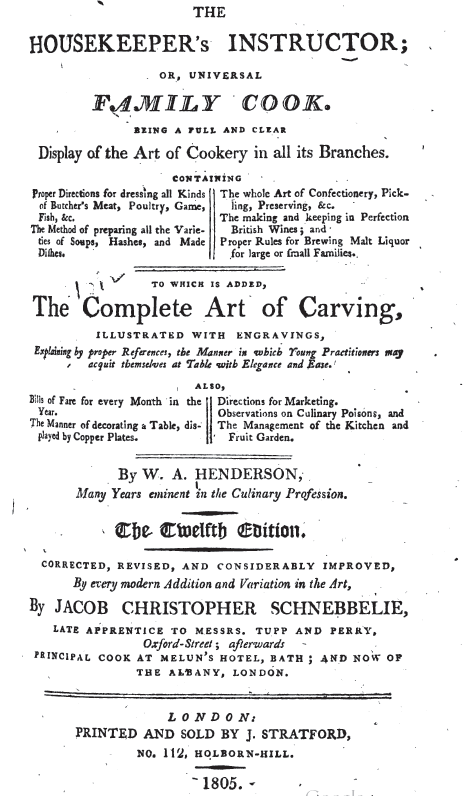I love old recipe collections! Generally, my preferred time periods are Medieval & early Modern, early American, and British Regency-era but honestly, I just love old recipes. I love looking at dishes that are very similar to modern ones and also seeing how food and tastes have changed over time. Plus, I love the challenge of recreating the dishes.
I wanted to take a look at a particular cookery book that I’m planning on recreating several recipes from but I figured I’d do a post to introduce the text I’ll be examining.

The book I am using is the 12th edition printed in 1805 by William Augustus Henderson and this edition was further contributed to and edited by Jacob Christopher Schnebbelie. The digitized version of this book is available on Google Books (link). This was a very popular cookery book of its time, originally published in 1791 and reprinted in 17 different editions (the last printed in 1823) with the later editions having contributions and editing by Jacob Schnebbelie.
In addition to a large collection of recipes both savory and sweet as well as recipes for wine, distilled cordials, and brewing. It also contains some sections on how to carve various meats (with pictures!), menu suggestions, table decorating, shopping at the market, and kitchen garden management.

Contents:
- Introduction
- Soups and Broths
- Boiling in General
- Roasting in General
- Baking
- Broiling
- Frying
- Stewing
- Hashing and Mincing
- Fricasseeing
- Ragoos
- Gravies, Cullises, and other Sauces
- Made Dishes
- Vegetables and Roots
- Puddings
- Pies
- Pancakes and Fritters
- Tarts and Puffs
- Cheesecakes and Custards
- Cakes, Biscuits, &c.
- The Art of Confectionary
- Pickling
- Collaring
- Potting
- Curing Various Kinds of Meats, Sousings, &c.
- Methods of Keeping Vegetables, Fruits, &c.
- Possets, White-Pots, Gruels, &c.
- Made Wines, &c.
- Cordial Waters
- The Art of Brewing
- Directions for Trussing Poultry, &c.
- The Complete Market-Woman
- The Art of Carving
- The Housekeeper’s Calendar
- Supplement
- Addenda
- Index
Most recipes of this era are quite a bit different from modern recipes. In modern cookbooks, we expect to see a clear and concise listing of all ingredients and full step-by-step instructions (sometimes with photos) for preparation and cooking. Early cookbooks usually just give a brief description of ingredients (but may or may not tell you how much) and preparation. They are notations for people who are already familiar with cooking and the preparation of similar dishes. The text often relies on you having knowledge or can extrapolate from the other recipes in the collection.
For example, the first recipe I’ll be recreating is a bread pudding but there is no indication in the recipe for how to cook it. It is in the section for Baked Puddings so I can make the assumption that it is baked in an oven (as opposed to being boiled or steamed). Another recipe I’ll be testing out is for a beef stew but the recipe does not give any indications for how much of each ingredient to use.

A modern cook can also come upon ingredients that aren’t used as much or cooking terminology that is unfamiliar. Sometimes the methods of cooking described are different because they were usually cooking at a hearth or fireplace so cooking notations might refer to the heat of the fire or coals instead of a temperature degree on an oven setting.
For example, in the table of contents above, there is Roasting, Baking, and Broiling. Modernly, in most US kitchens, these are all done in the oven. But here, they are describing three different cooking techniques. Roasting tends to be over or next to open fire, usually on a spit. Baking is in an enclosed heated vessel like a dutch oven. Broiling is cooking on a gridiron or metal grill over an open flame (what we would call grilling or barbequing). Side note: modernly in England grilling is what we call broiling in the US; and barbequing is what we (generally) call grilling in the US. I won’t even go into all the nuances of the term barbeque in the US because it can be used as a noun and a verb and have different meanings.
I’m looking forward to trying out some of these different recipes and exploring this book further over 2022 so check back to see what other treasures I find in this text.
I’ll leave you with the frontispiece of this book with the large portrait of the editor (apparently considered more important than the original author now), J. C. Schnebbelie, and below the portrait is an engraving of the front of The Albany where he was currently working when this edition was published. The Albany was a mansion that was converted into batchelor apartments in 1802. Residents have included the poet Lord Byron and the future Prime Minister William Gladstone, and numerous members of the aristocracy. It’s also featured in novels as the residences of some of the characters. Which is just a cool side note to place this cook in history.

1 thought on “The Housekeeper’s Instructor – A Cookery Book from 1805”